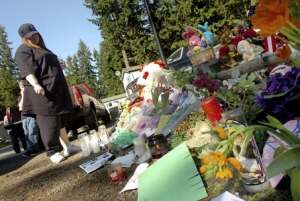A Placemaking Journal
Considering Community in the Face of Tragedy
Something terrible happened in my neighborhood.
The specific details of the incident have been covered elsewhere and are not especially relevant to my point here so I’ll spare you the rehash. Suffice it to say that, during what was reportedly a messy divorce, one of my neighbors killed his five year old son rather than share custody with his soon to be ex-wife.
There’s no logic to his actions, which makes it of little surprise that the common emotional thread that subsequently weaved its way through the community was one of profound and pervasive confusion.
“How could this happen,” we all asked, “and what can we do?”

In the course of these discussions–which happened everywhere, from the neighborhood coffee shop to the local blogs that cover community news–someone suggested a makeshift floral memorial in a centrally located neighborhood park. Word was spread. A local florist made a contribution. Permission was secured from the city.
Come, they suggested, and leave a token of your prayers and support.
A day later, I passed by the memorial site and felt an almost knee-jerk sense of dread. Despite the widely distributed and discussed invitation, there was little to show but a few bouquets. So few in number that it wasn’t even clear what was happening.
Where was the mountain of flowers, stuffed animals and scribbled notes so prevalent on the news whenever community tragedy occurs? Could it be that the sense of community I’ve always felt here, and have even held up as an example of the compelling relationship between physical form and human interaction, was some kind of illusion?
But the more I stepped back, the more I found evidence to the contrary. Instead, some in the community had set up a fund through the local bank to help cover funeral expenses. Others were organizing the series of meals that could help carry the family through their ordeal. There were even those helping to insulate the mother from the glare of media exploitation.
All of which seems entirely more meaningful than simply showing one’s concern in the form of flowers, however sincere that offering may be.
The media has conditioned us to believe that, in the cultural malaise that constitutes our postmodern life, a makeshift memorial is the appropriate expression of community grief. That it demonstrates in towering ways a community’s strength and connectedness. But the more I thought about it, the more I realized that perhaps the opposite is true.
Maybe these mountainous piles of mementos instead reflect the frustration of having a very human desire to contribute in some way while having absolutely no idea how to go about doing so, or where to turn to find out.
Maybe they’re less an indicator of connected community and more an indicator of fractured community.
Taken in that light, I suddenly had a newfound appreciation for that feeble little collection of flowers, because its entirely unimpressive stature now seemed as much a monument to my community’s ability to come together in more purposeful ways as it was to that little boy.
We’re social animals. We want to be together. Now, more than ever, we need a return to principles of community design and development that foster, rather than thwart, such inclinations.
In short, we need more places that, in bringing us together, ultimately help us to help each other.
— Scott Doyon








